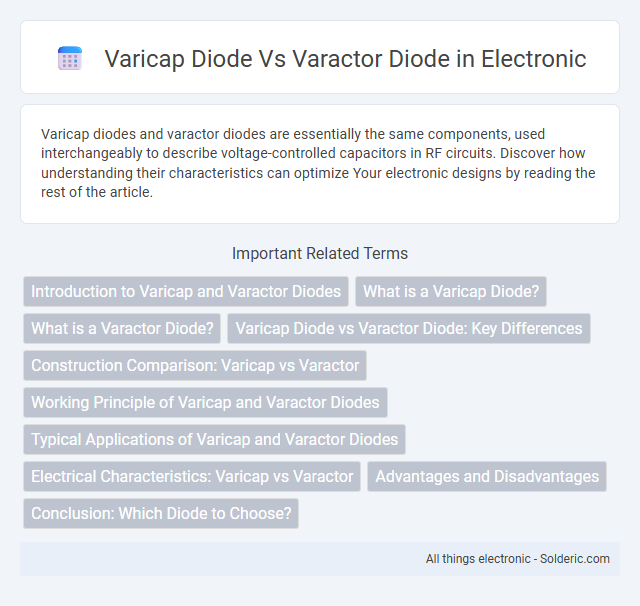Varicap diodes and varactor diodes are essentially the same components, used interchangeably to describe voltage-controlled capacitors in RF circuits. Discover how understanding their characteristics can optimize Your electronic designs by reading the rest of the article.
Comparison Table
| Feature | Varicap Diode | Varactor Diode |
|---|---|---|
| Definition | A semiconductor diode designed to act as a variable capacitor under reverse bias voltage. | Another term for Varicap diode; used interchangeably. |
| Primary Function | Voltage-controlled variable capacitance for tuning circuits. | Identical to Varicap - used for tuning and frequency modulation. |
| Applications | RF tuning, voltage-controlled oscillators (VCOs), frequency modulators. | Same applications as Varicap diode; no difference. |
| Operation | Reverse bias voltage changes the width of the depletion region altering capacitance. | Same operation principle as Varicap diode. |
| Terminology | Commonly used term in Europe and academic texts. | More common in the US and some technical literature. |
| Conclusion | Varicap and Varactor diodes are synonymous with no functional difference. | Identical device, different naming conventions. |
Introduction to Varicap and Varactor Diodes
Varicap diodes and varactor diodes are semiconductor devices designed to exploit the voltage-dependent capacitance of a p-n junction. These diodes function as variable capacitors in RF circuits, enabling frequency tuning in oscillators, filters, and voltage-controlled oscillators (VCOs). You benefit from understanding that both terms refer to the same component, with "varactor" being a more widely used term in modern electronic design.
What is a Varicap Diode?
A Varicap diode, also known as a Varactor diode, is a semiconductor device designed to exploit the voltage-dependent capacitance of its p-n junction. It functions primarily in tuning circuits, such as voltage-controlled oscillators and frequency modulators, by varying capacitance in response to applied reverse voltage. Understanding the characteristics of Varicap diodes can enhance Your ability to design efficient RF and microwave components.
What is a Varactor Diode?
A Varactor diode, also known as a Varicap diode, is a semiconductor device designed to exploit the voltage-dependent capacitance of a reverse-biased p-n junction. Primarily used in radio frequency (RF) circuits, its capacitance varies with applied voltage, enabling electronic tuning in oscillators, filters, and frequency modulators. This unique property makes the Varactor diode essential for adjustable frequency applications in communication systems.
Varicap Diode vs Varactor Diode: Key Differences
Varicap diodes and varactor diodes are essentially the same semiconductor device used for voltage-controlled capacitance in tuning circuits. The key difference lies in terminology: "varicap" is commonly used in European contexts, while "varactor" is preferred in American English. Both diodes function by varying their junction capacitance with applied reverse voltage, making them crucial in RF design for tuning filters and oscillators.
Construction Comparison: Varicap vs Varactor
Varicap diodes and varactor diodes share identical construction, both consisting of a semiconductor PN junction designed to vary capacitance with applied reverse voltage. The key distinction lies not in their structure but in terminology preference, as "varactor" is a generic term while "varicap" is a registered trademark. Your choice between the two depends on context rather than any physical or functional differences in their construction.
Working Principle of Varicap and Varactor Diodes
Varicap and varactor diodes operate based on the principle of voltage-dependent capacitance in a reverse-biased pn junction, where the depletion region width varies with applied voltage, altering the junction capacitance. These diodes function by exploiting the capacitance change to tune resonant circuits in RF design and voltage-controlled oscillators. Both terms are often used interchangeably, as they share the same fundamental working mechanism.
Typical Applications of Varicap and Varactor Diodes
Varicap and varactor diodes are commonly used in RF design for voltage-controlled tuning applications such as frequency modulation, phase-locked loops, and voltage-controlled oscillators. These diodes enable precise adjustment of capacitance in resonant circuits, making them ideal for use in television tuners, RF filters, and antenna matching networks. Your choice between varicap and varactor diodes depends on the specific tuning range and frequency stability required in your electronic design.
Electrical Characteristics: Varicap vs Varactor
Varicap diodes and varactor diodes share nearly identical electrical characteristics, both operating as voltage-dependent capacitors used in tuning circuits. Their capacitance varies inversely with the applied reverse voltage, enabling frequency modulation in RF applications. Understanding these subtle electrical nuances helps you select the right diode for precise voltage-controlled tuning performance.
Advantages and Disadvantages
Varicap diodes and varactor diodes function similarly as voltage-controlled capacitors in tuning circuits, but varicap diodes generally offer higher Q-factor and greater linearity, enhancing signal quality and frequency stability. Varactor diodes provide compact size and ease of integration in RF designs but may exhibit lower tuning range and increased nonlinearity under certain conditions. Your choice depends on specific performance requirements such as noise sensitivity, tuning range, and circuit complexity.
Conclusion: Which Diode to Choose?
Varicap diode and varactor diode are fundamentally identical semiconductor devices used for voltage-controlled capacitance in RF circuits. Your choice depends on the application terminology preference rather than device performance, as both terms describe the same diode type commonly employed in tuning circuits, voltage-controlled oscillators, and phase-locked loops. Selecting the correct component involves ensuring specifications match your frequency range, capacitance variation, and quality factor requirements.
Varicap diode vs Varactor diode Infographic

 solderic.com
solderic.com